Last updated on
Finding mouse poop in your couch is not only alarming because it reveals a lurking rodent problem, but it also poses potential health risks that necessitate immediate action.
Discovering mouse droppings in your couch can be an alarming experience, but don’t panic! There’s a methodical approach to handling this situation.
First, you’ll need to clean the affected area thoroughly, then take steps to prevent future infestations.
This article will guide you through the entire process, from identifying the problem to implementing effective solutions. It’s packed with expert advice and practical tips, ensuring you have all the information you need to tackle this issue head-on.
Let’s dive into the details!
Key takeaways:
- Mouse droppings are small, pointed at both ends, and vary in color depending on age.
- Rat droppings are larger and capsule-like, while mouse droppings are more spindle-shaped.
- Signs of a mice nest in a couch include small bite marks, accumulation of droppings, shredded material, gnawed wires or woodwork, and musty odors.
- Mice can cause damage to furniture by shredding upholstery or foam, leaving tracks, and creating foul odors.
- To clean mouse droppings from fabric, use gloves, disinfectant spray, hot soapy water, and consider steam cleaning.
Table of Contents
Identifying Mouse Poop in Your Couch
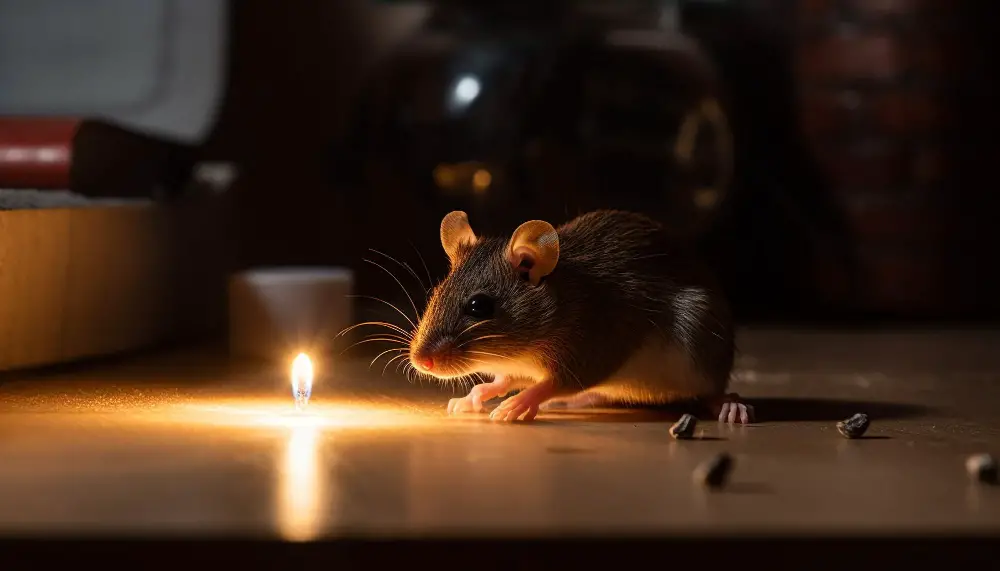
Knowledge of rodent droppings will help in determining if you have an infestation. Mouse droppings are small, around 1/4 inch, and pointed at both ends. Their color varies from black to brown, depending on the age. Droppings are often found scattered randomly during an infestation, not confined in small areas.
When you notice such marks on your couch or anywhere around, this could be a clear pointer to a mouse infestation. Remember, mouse droppings aren’t just unsightly – they can pose major health risks, too, making swift action even more crucial.
What Do Mouse Droppings Look Like
Mouse droppings are typically small, dark and pellet-like in appearance, usually about the size of a grain of rice. They are often found scattered randomly, not in large piles, as mice defecate while moving around. Beware of droppings that are moist or dark in color as they are fresh and a signal of recent activity. Older droppings will look gray and dry. The ends of the poop are usually pointed or round. A distinctive feature is the odor; the smell can be strong and musky if the infestation is significant. One mouse can produce up to 80 droppings a day; thus regular sightings could indicate multiple mice. Always wear protective gloves and masks when dealing with mouse droppings due to health risks.
Mice Dropping Vs. Rat Droppings
In discerning between the two, consider the size first. Rat droppings typically measure about half an inch long, significantly larger than those of mice, which are usually a quarter of an inch or smaller.
Another difference is the shape. Rat droppings tend to be capsule-like, with blunt ends, while mouse droppings are often more spindle-shaped with pointed ends.
Lastly, fresh droppings of both types are soft and moist, but as they age, rat droppings are likely to become darker and harder than mouse droppings.
It’s crucial to identify the correct rodent to tailor your subsequent pest control strategy.
Signs of Mice Nest in Couch
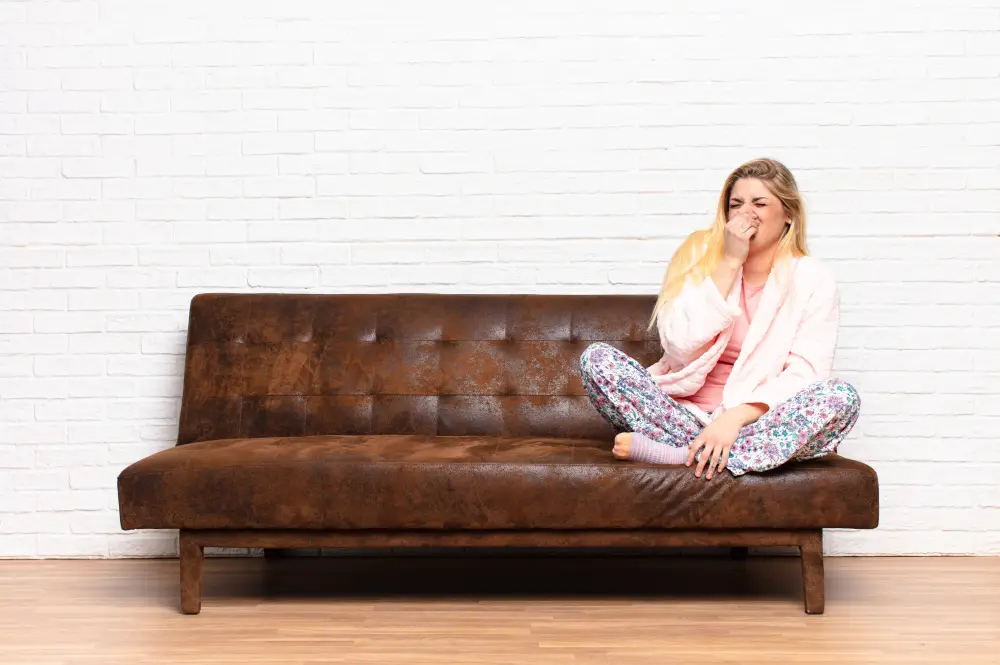
When you take a closer look, you’ll likely spot the signs of a mice nest. Spotting these signs early can protect your couch from significant damage and prevent potential health concerns. To uncover invisible signs, use a flashlight to better inspect the nooks and crannies of your furniture.
1. Small Bite Marks on Fabric: Close inspection might reveal tiny punctures or nicks on your couch’s cover. Mouse teeth are sharp and can easily bite through fabric.
2. Accumulation of Droppings: Regular presence of fresh droppings usually indicates an active nest in your couch. The size of droppings is typically rice-grain-sized.
3. Shredded Material: Mice use surrounding materials to build nests. If you find chewed-up foam, fabric strips, or stuffing, you may have mice.
4. Gnawed Wires or Woodwork: When mice aren’t building or maintaining their nests, they gnaw to keep their teeth sharp. Look for chewed areas around the base of the couch.
5. Musty Odors: Your senses can help too. A mouse nest in a couch usually carries a distinctive, musky odor. Take a whiff—if it’s unpleasant, you might have unwelcome guests.
By being vigilant, you can address the problem promptly.
Damage To Furniture By Mice

Signs of damage from a mice infestation are varied. Most commonly, you’ll notice small gnaw marks or shredded material in your couch, typically hidden in less visible areas like the underside or back corners. Mice have sharp incisor teeth that never stop growing and in order to keep them in check, these rodents often need to bite or chew on materials, including your furniture.
Shredded upholstery or foam can often be found in and around the couch in severe cases. It’s used by mice to create their nests, typically stowed away in cozy and dark corners of the furniture. Not only does this physical damage affect the comfort and aesthetic appeal of the couch, but it compromises its structural integrity, leading to an uncomfortable and possibly unsafe seating experience.
Additionally, there may be evidence of mice tracks around the couch. While they might be hard to notice on certain materials and color palettes, a closer inspection might reveal tiny footprints and tail drag lines, indicating a recent mouse presence. The weight of mouse traffic and urine trails can add up, causing undue wear and tear on the fabric over time.
Lastly, foul odors are frequently associated with rodent infestations. Genuine leather and certain fabric materials can absorb the scent of mouse urine and feces, subjecting homeowners to a lingering smell even after the mice have been removed.
How to Clean Mouse Droppings From Fabric
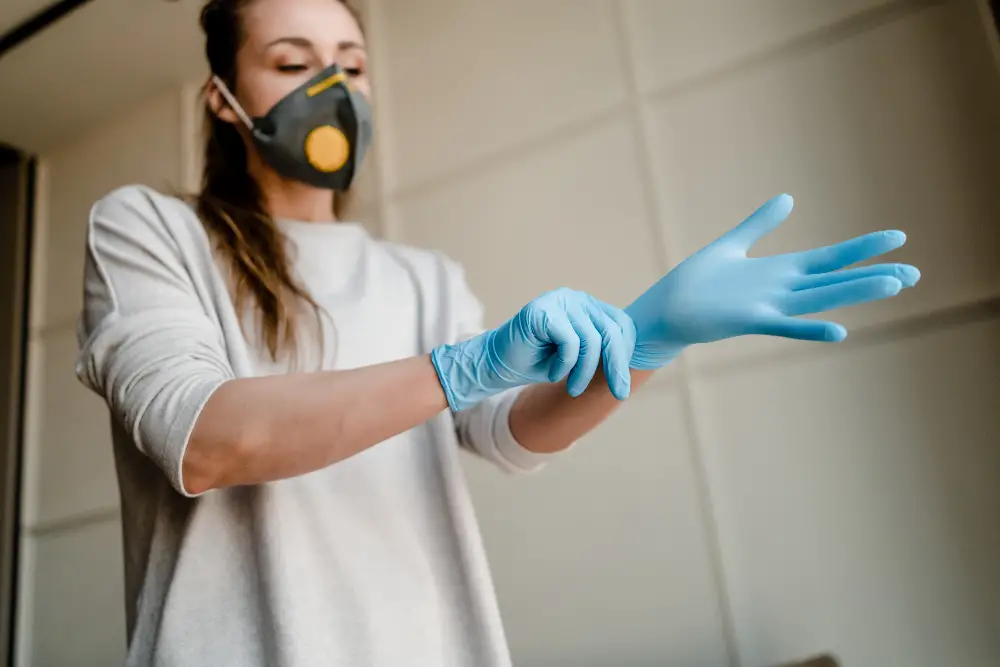
Begin by wearing gloves, preferably rubber or latex. Safety is paramount as mouse droppings carry harmful bacteria and viruses. Apply a disinfectant spray thoroughly on the affected areas and let it sit for at least 15 minutes. This is crucial in killing off germs and pathogens that may be present.
After applying the disinfectant, use a sponge or cloth dampened with hot soapy water for wiping the fabric clean. Following this, dispose of the gloves and cleaning materials in a sealed bag to avoid spreading contamination.
For stubborn stains, a clean cloth dampened in hydrogen peroxide or mild bleach could be used. But do ensure it doesn’t discolour or damage your upholstery. Additionally, consider steam cleaning the fabric, as high temperatures can effectively kill certain pathogens. Remember, do not vacuum as it might aerosolize the droppings and potentially spread any diseases present.
Lastly, always make sure to wash your hands thoroughly after each cleaning session and air out the room if possible.
The Dos and Don’ts of Cleaning Mouse Poop From Your Couch
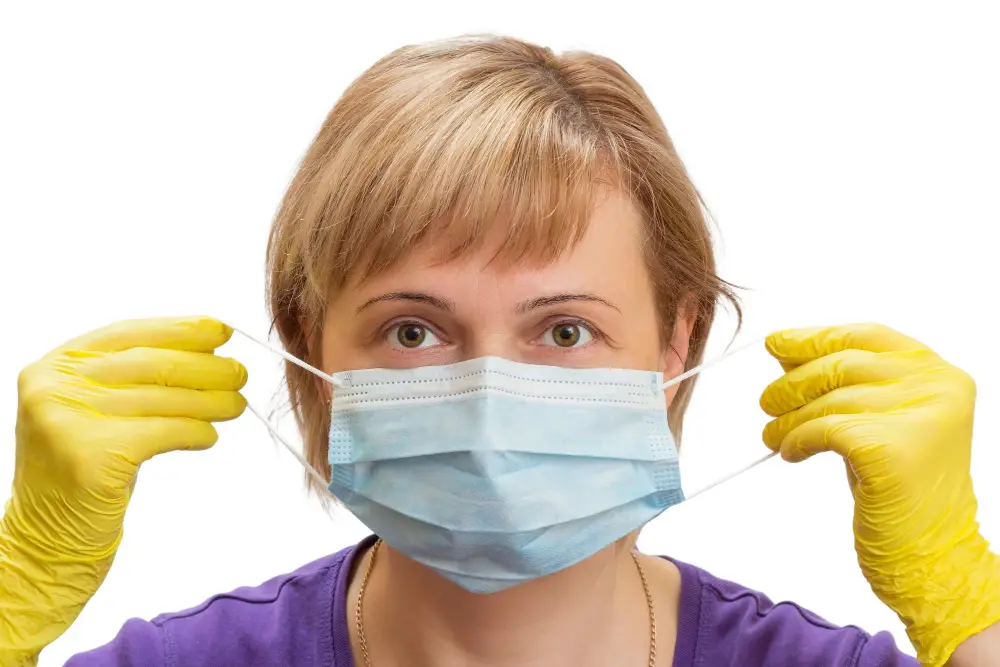
When dealing with a mice issue, knowing the correct way to sanitize your couch is crucial. Following is a list of dos and don’ts to guide you through the process:
Do:
- Wear protective gloves and mask: Mouse feces contain harmful bacteria that can lead to diseases, so it’s important to cover your nose, mouth, and hands before starting the cleaning process.
- Use a bleach solution: This kill-pathogens power comes in handy. Mix one part bleach to nine parts water for an effective disinfectant.
- Double bag the waste: This makes sure no bacteria leak out and spread after disposal.
- Ventilate the area: Following cleanup, airing out the room can help get rid of any lingering odors or bacteria.
Don’t:
- Sweep or Vacuum Droppings: This can cause the bacteria to become airborne, making it easier to inhale.
- Use Warm Water: Warm water can cause bacteria to multiply. Always use cold or room temperature water mixed with the bleach solution.
- Touch Droppings with Bare Hands: This could cause bacteria transfer, always use a tool to pick them up.
- Leave Any Droppings Behind: Meticulous cleaning is required, as even a tiny bit of feces left behind can attract more mice.
Remember, health and safety should always be the priority when dealing with any form of infestation.
How To Clean A Couch After Mice Infestation
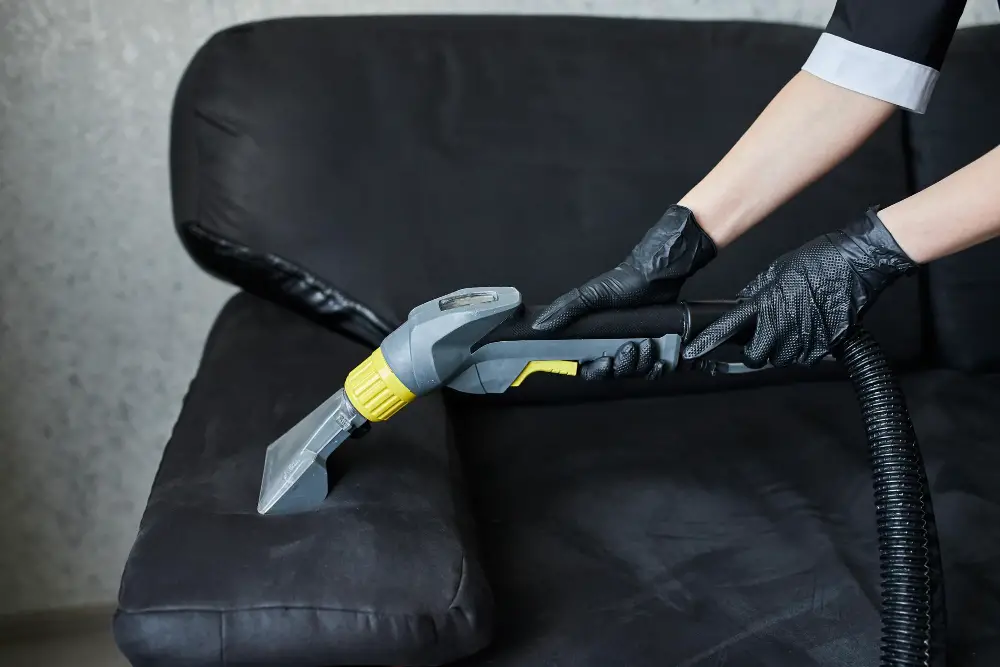
Begin by vacuuming the entire couch using the crevice tool to reach inside seams and in-between cushions. Remember always to wear gloves and a mask to prevent inhalation or direct contact with any lingering droppings.
Next, prepare a solution of one part bleach to nine parts water. This ratio is vital to effectively sanitize the affected area without causing undue damage to the fabric’s color or integrity.
Generously spray the bleach solution onto the couch, focusing on areas where droppings were discovered or where you suspect activity. Allow it to sit for five minutes before blotting with a clean towel.
To address potential odor issues, spray an enzymatic cleaner developed specifically for removing biological smells. Let it dry naturally.
For persistent stains, renting an upholstery steam cleaner may be necessary. While managing this process, remember to use upholstery detergent and follow the machine’s instructions meticulously.
Lastly, do not forget to regularly check and treat the couch for any new signs of infestation for the next few weeks.
How to Prevent Mice Infestations in Your Couch
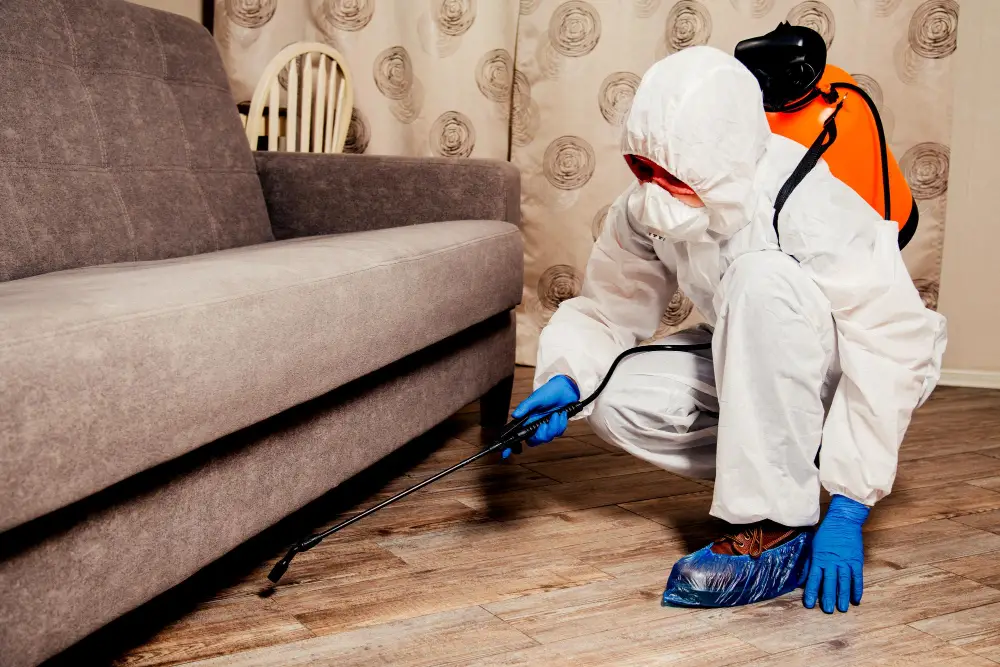
To stave off further infestations, consider the following effective measures:
1. Seal Entry Points: Examine your home for small holes or cracks that can serve as entry points for mice. Blocking these places with steel wool or caulk can prevent the critters from invading your living space.
2. Cleanliness: Always keep your surroundings clean. Mice are attracted to food scraps, so make sure to clean up after meals and store food properly.
3. Professional Pest Control: If infestations persist, it might be necessary to hire a professional pest control company. They have the expertise and materials for longer-term prevention.
4. Use of Repellents: Natural or synthetic mouse repellants can also help. Consider using peppermint oil, a natural deterrent, around potential points of access.
5. Minimize Clutter: Declutter your space, mice are known to nest in undisturbed, cluttered areas. By keeping your home tidy, you deter them from setting up shop.
Implementing these strategies proactively can help safeguard your couch and overall living space from mice.
Can Mice Live in Couches?
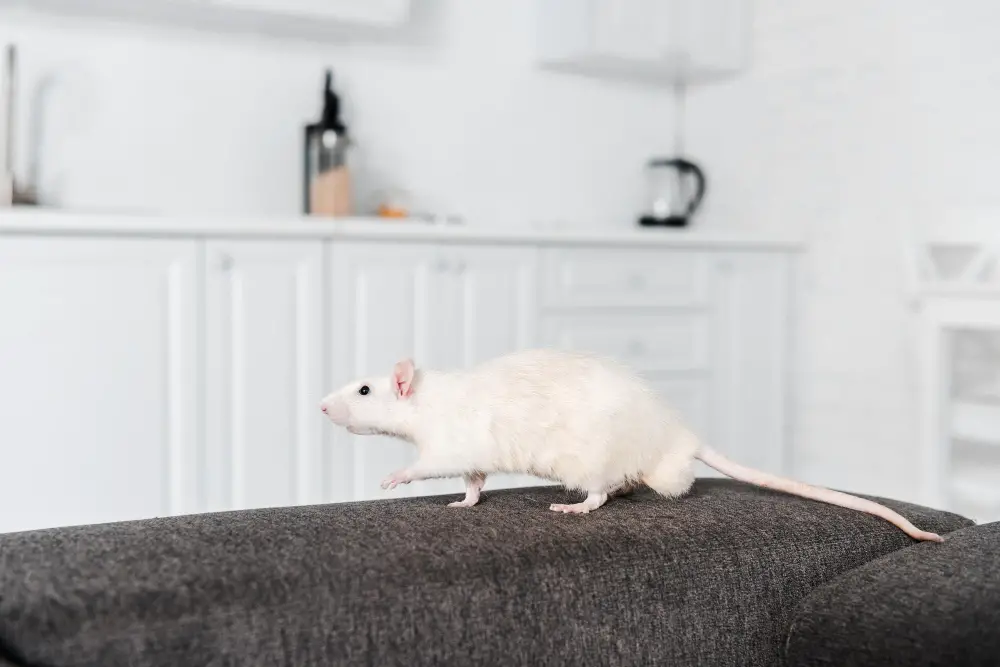
Indeed, the cozy, warm environment of couches makes them an attractive nesting place for mice. They offer plenty of padding for burrowing, and are often close to food sources.
Mice are excellent climbers and can easily climb into a sofa from the ground, further facilitated by holes or gaps in the fabric. Over time, the pests create intricate tunnels within the couch, damaging the internal structure.
Evidence of such infestation can be gnawed fabric, droppings, or an unusual smell. Rodent nests should be taken seriously, as mice multiply quickly and can cause considerable damage.
How to Keep Mice Away From Your Couch or Sofa
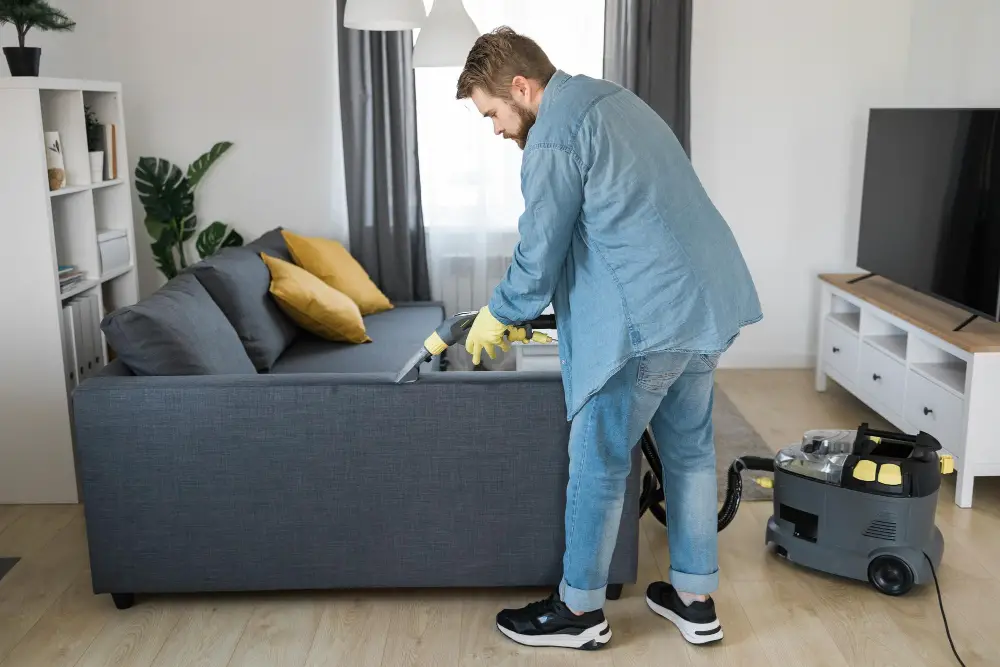
Maintaining regular cleaning routines assists in discouraging mice. Vacuuming inaccessible crannies and nooks under the cushions, and along the couch sidelines removes particles that attract mice.
For secondary prevention, ensure all food and edible items are securely stored. Avoid eating on the couch to prevent spillage and crumbs which are a food source for mice.
Use natural deterrents. Certain smells, like peppermint, eucalyptus, and clove essential oils are disliked by mice. Dabbing these oils on cotton balls and placing them near the couch can deter these uninvited guests.
Seal potential entrances. Mice infiltrate through gaps as small as a quarter inch. Regularly check your house for cracks, crevices or holes, and promptly seal with steel wool, caulk, or metal flashing.
Lastly, use mousetraps placed strategically around the home, particularly along the walls and behind the couch. Attract mice using bait like peanut butter or chocolate, ensuring not only their capture but also detection of their presence.
Remember, preventing mice infestation is always easier than dealing with an active one.
Health Risks Associated With Mouse Droppings On Couches

Exposure to mouse droppings can potentially lead to several health-related issues, some of which could be severe. Hantavirus Pulmonary Syndrome (HPS) is a primary concern, a severe respiratory disease contracted from infected rodents, including mice. The accumulation of droppings can also lead to allergen accumulation, inviting allergy symptoms and asthma flare-ups.
Rodents can potentially carry the bacteria that cause salmonellosis, a type of food poisoning. The presence of these microorganisms in a living space poses a risk. Additionally, the rare but serious disease, Lymphocytic Choriomeningitis (LCM) can be acquired through exposure to mouse droppings.
For these reasons, it is important to handle the situation with caution and seek professional help if necessary. Prevention, regular maintenance, and early intervention are crucial when dealing with potential rodent infestations.
FAQ
Is it safe to sleep in a room with mouse droppings?
No, it is not safe to sleep in a room with mouse droppings due to the risk of contracting harmful diseases such as Hantavirus Pulmonary Syndrome and Salmonella.
Will mice nest in couch?
Yes, mice can indeed nest in couches as these provide a cozy environment with readily available nesting materials.
How long do mouse droppings remain infectious?
Mouse droppings can remain infectious for a period of 2 to 3 days at room temperature, with exposure to sunlight potentially shortening this duration and colder temperatures likely extending it.
What should you do if you are exposed to mouse droppings?
In the event of exposure to mouse droppings, seek immediate help from a health care provider who can test for potential issues like hantavirus infection, especially if symptoms such as fever, fatigue, or shortness of breath are present.
What are the health risks associated with exposure to mouse droppings?
Exposure to mouse droppings can lead to serious health risks such as Hantavirus, Salmonellosis, and the Bubonic Plague.
How to properly clean a couch infested with mouse droppings?
To properly clean a couch infested with mouse droppings, first don a pair of gloves, then vacuum the droppings before disinfecting the area with a bleach and water solution, allowing it to air-dry, and finally vacuuming again for a thorough clean.
What are effective prevention measures to hinder mice nesting in a couch?
To prevent mice from nesting in a couch, maintain cleanliness, block potential entry points, place peppermint oil as a natural repellent around the couch, and consider using ultrasonic devices that emit a frequency unpleasant to mice.




